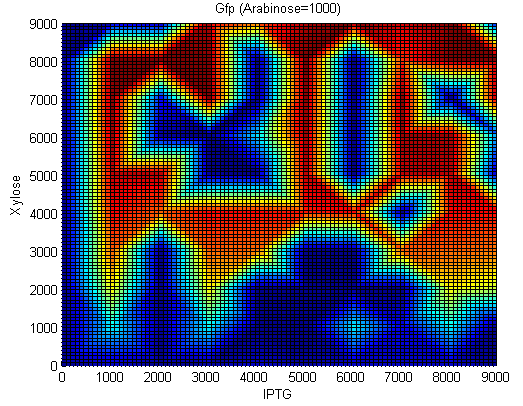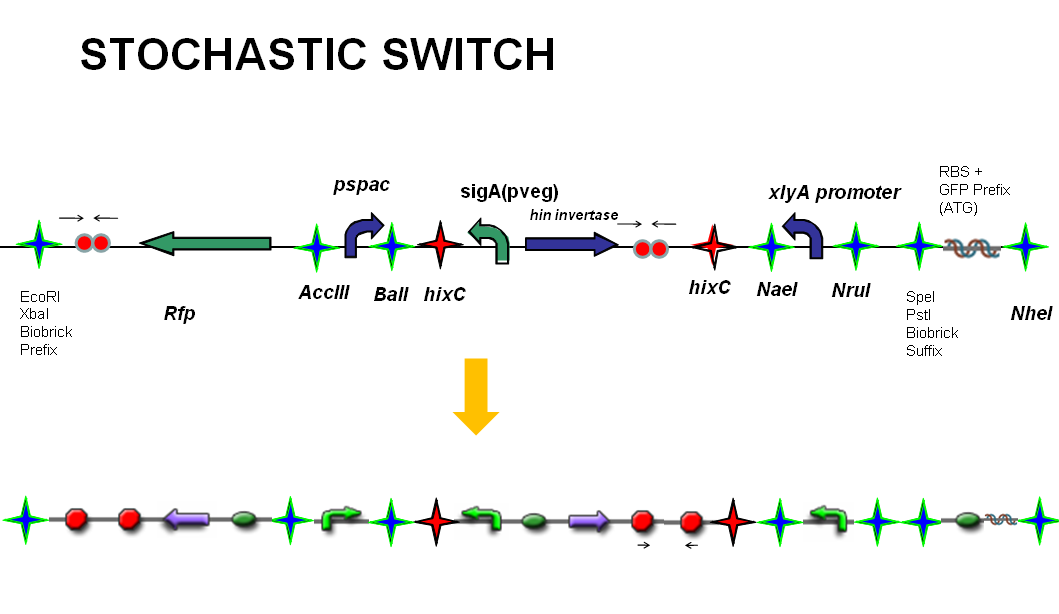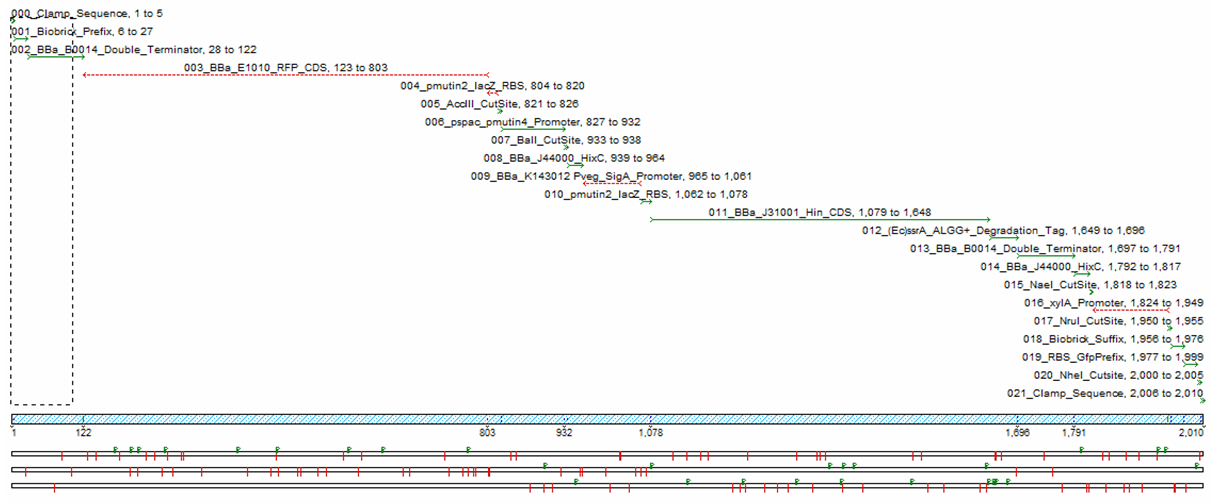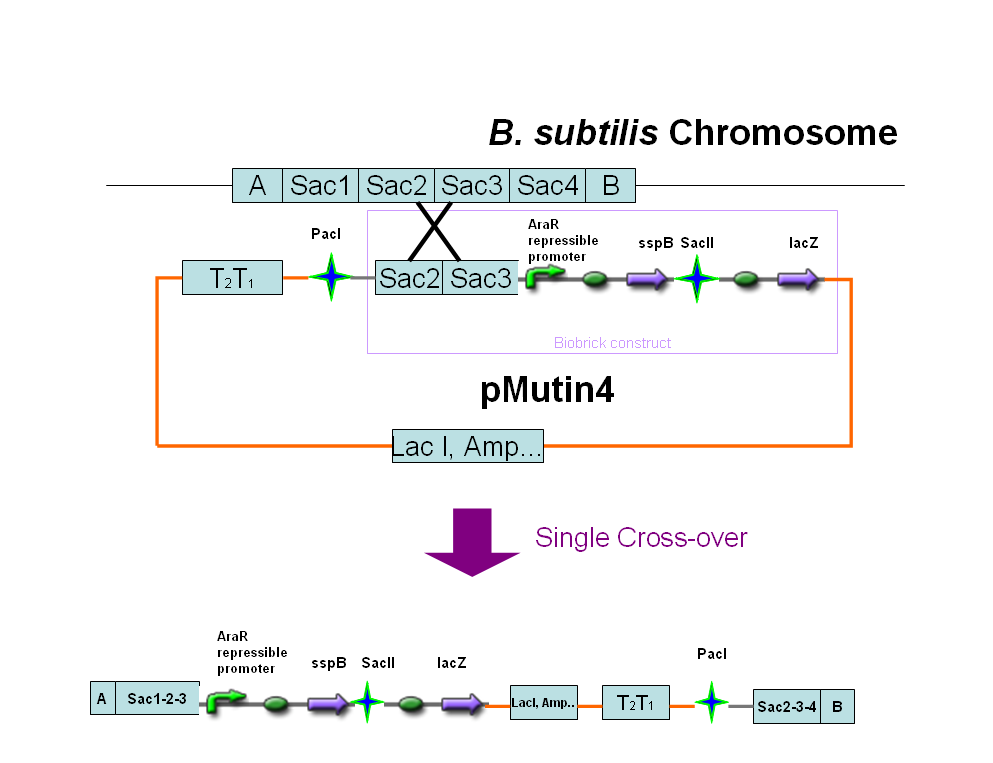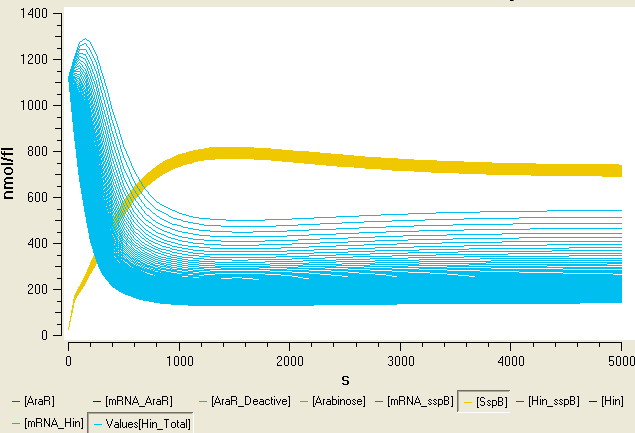Team:Newcastle/Stochasticity
From 2009.igem.org
| Line 81: | Line 81: | ||
'''Stocks 2''' is another stochastic simulation tool which also uses Gillespie’s direct method and supports SBML. | '''Stocks 2''' is another stochastic simulation tool which also uses Gillespie’s direct method and supports SBML. | ||
CellML model for the expression of Hin system | CellML model for the expression of Hin system | ||
| - | |||
| - | |||
We have used computational modelling in Matlab to try to determine how to make our system tuneable. | We have used computational modelling in Matlab to try to determine how to make our system tuneable. | ||
Revision as of 16:25, 21 October 2009
Stochastic Switch
Introduction
One of the most unique aspects of our project is our synthetic stochastic switch which regulates the decision to be a metal container spore, or a spore that can go on to germinate as part of the normal life cycle. Whilst stochastic oscillators have been implemented before using transcriptional regulators, our switch makes use of an invertable DNA segment to ensure that the decision is heritable.
Novelty in this sub-project
We intend to design a synthetic stochastic switch by using an invertible segment of our DNA that codes a promoter. Depending on the direction of the promoter, coding sequences will be expressed which reflect the decision to be a metal container or not. We also plan to tune the natural stochasticity of the sporulation system towards greater sporulation rates by altering the rate Spo0A phosphorylation.
BioBrick constructs
There will be various bricks involved within the stochastic switch construct, both those involved in the complete system as well as those designed for testing within the lab. The stochastic brick construct uses the Hin invertase system in order to flip a promoter region between Hix sites. The directionality of the promoter determines whether the switch is 'on' or 'off'. When the promoter is facing right it allows transcription of genes that control:
- Prevention of germination
- Upregulation of sporulation rate
- Expression of the metal sponge (SmtA)
- Decreased cadmium efflux
- Upregulation of cadmium import
The following diagram shows our stochastic construct:
Prevention of germination
The prevention of germination is governed by another invertase switch. Once the stochastic promoter faces right, a FimE protein is expressed which inverts a further promoter region. This promoter controls expression of the CwlD and SleB genes knocked out within our chassis. If their promoter is in the correct orientation then the cell will be able to germinate and continue as a vegetative cell. However if their promoter has been flipped, the cell can not germinate following sporulation, and will be trapped as a metal containing spore.
Upregulation of sporulation rate
The upregulation of sporulation involves increasing KinA expression. kinA codes a kinase protein that phosphorylates the Spo0A protein to its active form. When the promoter region within our stochastic brick faces right, there will be increased KinA expression, and thus a greater sporulation rate.
Metal sponge and cadmium influx/efflux
Our stochastic switch decides whether the spores can germinate, or whether they are commited to be a metal containing spore that cannot germinate again. We need this switch as we cannot interrupt the natural life cycle of the bacteria, as a proportion have to go on to seed the next generation. Expression of the metallothionein fusion protein (CotC-GFP-SmtA), cadmium import channel (mntH) and the cadmium efflux channel (CadA) is also governed by the direction of the stochastic promoter. When the direction of promoter faces right, metallothionein fusion protein's expression will be triggered to soak the cadmium. While the import channel is upregulated, the efflux system's activity will be slowed down to increase the number of cadmium inside the cell.
Stochastic Brick
We have decided to get our stochastic construct synthesised, as trying to build the construct manually would be too time costly. The following sequencher diagram shows the components of the construct we had synthesised.
Testing construct
In order to test our construct we have had to redesign using inducible promoters governing Hin invertase expression. We have used promoters pSpac and pxylA (Induced by IPTG and Xylose) to test our system. We include cut sites around these promoters in order to replace them with SigmaA promoters once the construct has been characterised.(See sequencher diagram above)
Degradation controller
In order to have another level of control over the orientation of the promoter within the flipping region we have added a degradation tag to the hin invertase protein. The following paper describes how proteins including modified ssrA tags can be located to the ClpXP protease by an Sspb protein. This means that inducible Sspb expression can requlate degradation levels of the tagged protein.
[http://www3.interscience.wiley.com/journal/121415079/abstract?CRETRY=1&SRETRY=0 Inducible protein degradation in Bacillus subtilis using heterologous peptide tags and adaptor proteins to target substrates to the protease ClpXP ]
We have decided to put the Sspb protein under the control of an arabinose inducible promoter as the following diagram illustrates, also we have included a region of the sac gene in our construct, so that the region will integrate into the Bacillus genome at a region other than amyE.
We added a modified version of ssrA degradation tag onto the C-terminus of Hin protein. Hence expressed proteins are degraded by ClpXP. However mutations on the ssrA tag weaken the recognition by ClpX and the modified tags require SspB adaptor protein to be recognized. When SspB protein is expressed, the proteins tagged with modified version of ssrA tag are targeted for degradation, otherwise they remain stable.
In B. subtilis there is no sspB orthologue and SspB from E. coli works in B. subtilis. By regulating the levels of SspB by arabinose, we designed an inducable protein degradation device.
Wild type E. coli ssrA tag is AANDENY-ALAA (SspB recognition site – ClpX recognition site). As suggested in the paper, we took one of the modified ssrA tags to use in our system.
AANDENY-SENY-ALGG (SspB recognition site – SENY +4 Linker - ClpX recognition site)
This tag works well in B. subtilis however degradation tags can affect activity of proteins. Different degradation tags may have effect on the activity of different proteins. It has been shown that this tag effected the activity of ComA(1).
- Griffith, K. L., and A. D. Grossman. 2008. Inducible protein degradation in Bacillus subtilis using heterologous peptide tags and adaptor proteins to target substrates to the protease ClpXP. Mol. Microbiol. 70:1012-1025.
Stochastic Modelling Tools
Matlab can be used for stochastic modelling. Glasgow team used Matlab implementing Gillespie algorithm to incorporate noise among cells. They also used deterministic modelling using ODEs and compared their results. When the number of cells increase two approaches become similar since the noise is cancelled out.
Stocks 2 is another stochastic simulation tool which also uses Gillespie’s direct method and supports SBML. CellML model for the expression of Hin system
We have used computational modelling in Matlab to try to determine how to make our system tuneable.
Please see our modelling page for Matlab files on our stochastic switch model.
FimE switch
The FimE switch is a similar switch to the Hix system, however it acts as a latch, meaning once flipped, the segmant will not flip back.
- [http://genomics.lbl.gov/Stuff/TimHam-BandB-online%20version.pdf fimE switch for DNA re-arrangement]
A Tightly Regulated Inducible Expression System Utilising the fim Inversion Recombination Switch.(E. Coli) Timothy S. Ham, Sung Kuk Lee, Jay D. Keasling,Adam P. Arkin,Received 21 December 2005; accepted 2 March 2006 Published online 13 March 2006 in Wiley InterScience (www.interscience.wiley.com). DOI: 10.1002/bit.20916
We decided to use FimE to switch off or on the production of a protein of our choice, such as the genes involved in germination.
- [http://jb.asm.org/cgi/reprint/183/14/4190?maxtoshow=&HITS=10&hits=10&RESULTFORMAT=&fulltext=subtilis&searchid=1&FIRSTINDEX=880&resourcetype=HWFIG Control of the Arabinose Regulon in Bacillus subtilis by AraR In Vivo: Crucial Roles of Operators, Cooperativity, and DNA Looping]
- [http://ukpmc.ac.uk/articlerender.cgi?artid=310841 Binding of the Bacillus subtilis spoIVCA product to the recombination sites of the element interrupting the sigma K-encoding gene] =>...DNA rearrangement that depends on the spoIVCA gene product...
Bistability in Bacillus subtilis
Read this page to find more options for natural stochastic switches in Bacillus subtilis. Natural stochastic switches:Bistability in Bacillus subtilis
And to find out how we are tuning sporulation using our stochastic switch choice see the sporulation tuning page.
Lab strategies
To carry out our labwork we needed cloning strategies for all of our bricks and devices, please see our cloning strategies page for details on how we cloned our devices.
News
Events
- 20 – 21 June 2009 - Europe workshop (London)
- 23 – 24 June 2009 - UK iGEM meetup (Edinburgh)
- 23 October Practice Presentation (Newcastle)
- 23 October T-shirts are ready
- 27 October Practice Presentation (Sunderland)
- 27 October Poster is ready
- 30 October – 2 November 2009 - Jamboree (Boston)
Social Net
- Newcastle iGEM Twitter
- [http://www.facebook.com/home.php#/group.php?gid=131709337641 Newcastle on Facebook]
- [http://www.youtube.com/user/newcastle2009igem Newcastle Youtube Channel]
 "
"

